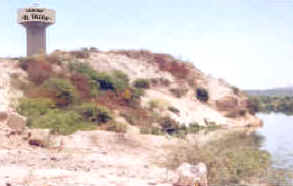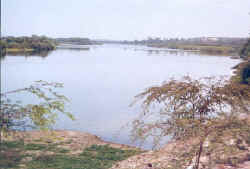SULLANA - LOMA DE MAMBRÉ
|
|
|
|
|
LOMA "MAMBRÉ" HILL "MAMBRÉ" HÜGEL "MAMBRÉ" |
|
LOMA "MAMBRÉ"
La loma Mambré tiene una altura de 82 m.s.n.m., ubicada al costado del cementerio “San José”. Comprende un acantilado con una altura de 12 metros en la desembocadura del canal vía o quebrada de Cieneguillo (a espalda del cementerio), que a su vez es la parte más baja del territorio que ocupa la ciudad. Los
primeros pobladores de Sullana se instalan alrededor de la loma de
Mambré, por los años de 1750, en pleno virreinato. No
hay una fecha concreta en la que se pueda señalar como fecha de
aniversario, hasta que llega el obispo Baltasar Martínez Compañón y
el 8 de julio de 1783 oficializa la fundación de Sullana con el nombre
de “El Príncipe”. En esta época Sullana era conocida como “La
Punta”. Pero
muchos años antes, en las inmediaciones de la Loma Mambré, campesinos,
mestizos y descendientes de españoles ya radicaban en este lugar. Era
el lugar mas accesible al río y punto de concentración de viajeros
provenientes de diferentes lugares. Inclusive, el río se podía cruzar
a pie por esta zona en épocas de poco caudal. Poco
a poco el pueblo fue creciendo y extendiéndose en las inmediaciones de
lo que hoy es la calle La Mar y las primeras cuadras e la calle San Martín. En
la Loma Mambré nace lo que hoy es la ciudad de Sullana y de allí su
importancia histórica. Por otro lado, hay una leyenda sobre el origen de este enorme montículo de arena, eterno guardián del valle del Chira
LA LEYENDA DE LA LOMA MAMBRÉ Y EL CERRO TEODOMIRO Cuentan
nuestros abuelos, lo que les contaron los abuelos de sus abuelos, que un
altivo y apuesto cacique tallán, desató las iras del dios tallán
Mec-Nom, creador del universo y protector de los hombres, osando robar
una bella capullana dedicada a su servicio. En esa época esta zona era
árida y no existía el valle del Chira.
A pesar de esconderse en lo más profundo de la cerrería, fueron
descubiertos por el ojo avizor de la divinidad y los conminó al
arrepentimiento. Pero el amor de la hermosa capullana y del decidido
tallán era tan inmenso que prefirieron el castigo y la muerte a vivir
separados. Fue en ese momento que se inició una gran tormenta con
grandes vientos, lluvias y la tierra se remeció apareciendo lo que hoy
es el hermoso valle del Chira. Al término de este cambio al que habían
sobrevivido los amantes,
Mec-Nom sentenció: -me han ofendido y deben recibir su
castigo. Este paraíso era para ustedes pero sólo podrán mirarlo. Así
será eternamente. Volverán a ser lo que fueron. Tú, refiriéndose a
la mujer, serás convertida en una inmensa loma de arena (loma Mambré).
Y tú, señalando al osado tallán, serás convertido en un cerro de
arena (cerro “Teodomiro”) y estarás allá. Tendrán abundante agua
a sus pies, pero no podrán tomarla. Habrá abundante vegetación, pero
jamás podrán tenerla, ni con el agua que yo les envíe desde el
cielo. Ambos estarán frente a frente, mirándose, pero jamás se tocarán-
Así fue como Mec-Nom creó el valle del Turicarami, con estos dos
enormes montículos de arena, míticos, tradicionales, que no encajan en
la geografía. Su origen se pierde en el tiempo, como el amor que se
profesaban. En su entorno se desarrolló una gran ciudad y muchas
generaciones han pasado y ellos, la loma y el cerro siguen allí,
vigilantes, como esperando que alguien termine con el encanto, recuperar
su apariencia humana y volver a reunirse en algún recodo del tiempo
para vivir eternamente su amor, en este paraíso que es el valle del
Turicarami.
|
HILL "MAMBRÉ" The hill Mambré has a height of 82 m.s.n.m., located to the side of the cemetery “San José”.
he Understands a cliff with a height 12 meters in the outlet of the channel via or gulch of Cieneguillo (to back of the cemetery) that in turn is the lowest part in the territory that occupies the city. The first residents of Sullana have settled almost for 200 years, in the middle of viceroyalty around the hill of Mambré. There is not a concrete date in which you can point out like anniversary date, until the bishop arrives Baltasar Martínez Compañón and July of 1783 oficializa 8 the foundation of Sullana with the name of “The Prince”. In this time Sullana was known as “The Tip.” THE LEGEND OF THE HILL MAMBRÉ AND Our grandparents count, what the grandparents of their grandparents counted them that a cavalier one and I bet cacique tallán, it untied the angers of the god tallán Mec-Nom, creator of the universe and protective of the men, daring to steal a beautiful bud dedicated to their service. In that time this area was arid and the valley of the Chira didn't exist. In spite of hiding in the deepest in the hills, they were discovered by the attentive eye of the divinity and it threatened them to the regret. But the love of the beautiful bud and of the resolved tallán it was so immense that they preferred the punishment and the death to live separate. It was in that moment that a great storm began with big winds, rains and the earth you remeció what today is the beautiful valley of the Chira appearing. At the end of this change to the one that the lovers had survived, Mec-Nom sentenced: They have offended -me and they should receive their punishment. This paradise was for you but they will only be able to look at it. It will be this way eternally. They are what you/they were again. You, referring to the woman, you will be transformed into an immense hill of sand (hill Mambré). AND you, pointing out to the fearless tallán, you will be transformed into a hill of sand (hill “Teodomiro”) and you will be there. They will have abundant water to their feet, but they won't be able to take it. There will be abundant vegetation, but they will never be able to have it, neither with the water that I send them from the sky. Both will be in front of front, being looked, but they will never be played - it was This way as Mec-Nom creó the valley of the Turicarami, with these two enormous mounds of sand, mythical, traditional, that don't fit in the geography. Their origin gets lost in the time, as the love that you/they were professed. In their environment a great city was developed and many generations have happened and they, the hill and the hill continue there, vigilant, as hoping somebody finishes with the charm, to recover its human appearance and meet in some corner of the time to live its love eternally again, in this paradise that is the valley of the Turicarami. |
HÜGEL "MAMBRÉ" Der Hügel Mambré hat eine Höhe von 82 m.s.n.m., fand zur Seite des Friedhofes “San José”. er versteht eine Klippe mit einer Höhe 12 Meter im Abfluß des Kanals über oder Bergschlucht von Cieneguillo (vom Friedhof zu unterstützen), daß dann ist der niedrigste Teil im Territorium, das die Stadt einnimmt. Die ersten Bewohner von Sullana haben sich fast 200 Jahre, in der Mitte von viceroyalty um den Hügel von Mambré, entschieden. Es gibt kein konkretes Datum, in dem Sie wie Jahrestag-Datum darauf hinweisen können, bis der Bischof Baltasar Martínez Compañón und Juli von 1783 oficializa 8 das Fundament von Sullana mit dem Namen von ankommt, “Der Prinz”. In dieser Zeit wurde Sullana als gekannt “La Punta.”
Unsere Großeltern zählen, das, was die Großeltern ihrer Großeltern sie zählten, daß ein anmaßendes und ich cacique-tallán wetteten, band es die Ärger des Gott tallán Mec-Nom auf, Schöpfer des Universums und schützend von den Männern das Wagen, eine schöne Knospe zu stehlen weihte zu ihrem Dienst. In dieser Zeit war dieses Gebiet dürr, und das Tal vom Chira existierte nicht. Trotz des Verstecken im tiefsten in den Hügeln wurden sie vom aufmerksamen Auge der Göttlichkeit entdeckt, und es drohte ihnen zum Bedauern. Aber die Liebe der schönen Knospe und vom gelösten tallán war es so riesig, daß sie die Bestrafung und den Tod vorzogen, Einzelteil zu leben. Es war in diesem Moment, daß ein großer Sturm mit großen Winden, Regen und der Erde Sie remeció das anfing, was heute das schöne Tal vom Chira Erscheinen ist. Am Ende dieser Änderung zum einen, den die Liebhaber überlebt hatten, verurteilte Mec-Nom: Sie haben-mich beleidigt, und sie sollten ihre Bestrafung bekommen. Dieses Paradies war für Sie, aber sie werden nur fähig sein, es anzuschauen. Es wird ewig dieser Weg sein. Sie sind, welche you/they wieder waren. Sie, beim Beziehen auf die Frau, Sie werden in einen riesigen Hügel von Sand umgestaltet werden (Hügel Mambré). UND Sie, beim Hinweisen zum furchtlosen tallán darauf, Sie werden in einen Hügel von Sand umgestaltet werden (Hügel “Teodomiro”) und Sie werden dort sein. Sie werden üppiges Wasser zu ihren Füßen haben, aber sie werden nicht fähig sein, es zu nehmen. Es wird üppige Vegetation geben, aber sie werden nie fähig sein, es zu haben, weder mit dem Wasser, das ich ihnen vom Himmel schicke. Beide werden vor Front gesehen habend, sein, aber sie werden nie gespielt werden-es war Dieser Weg das Tal vom Turicarami, mit diesen zwei enormen Hügeln von Sand, als Mec-Nom creó mythisch, traditionell, das paßt nicht in die Geographie. Ihr Ursprung wird in der Zeit, als die Liebe, die you/they erklärt wurden, verloren. In ihrer Umgebung wurde eine große Stadt entwickelt, und viele Generationen sind passiert, und sie, der Hügel und der Hügel setzen dort fort, wachsam, wie das Hoffen, daß jemand mit dem Charme, sein menschliches Aussehen wiederzufinden und in irgendeiner Ecke der Zeit zu treffen, um seine Liebe ewig wieder zu leben, in diesem Paradies, das das Tal vom Turicarami ist, beendet. |

